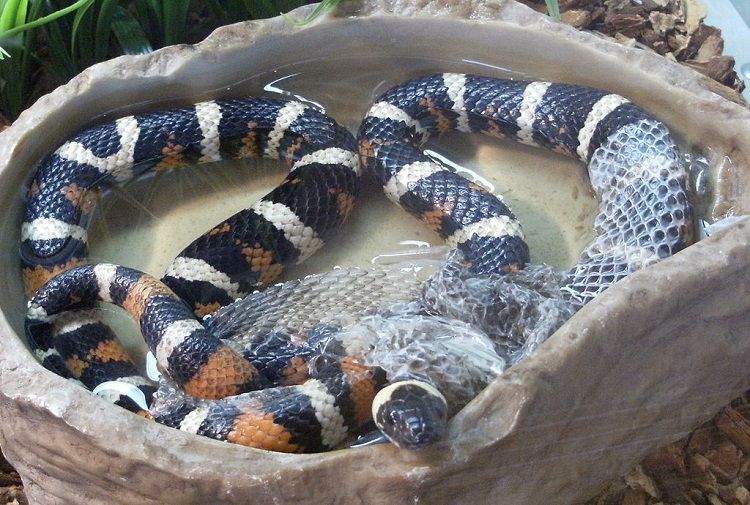Table of Contents
Most people are aware of the fact that snakes shed their skin, but most do not know why. Nor do they realize that while other animals (even humans) shed skin, snakes are unique in the fact that they shed their entire skin in one go! But why is this?
Snakes grow separately from their skins so when their body undergoes growth, they have to shed their old skin because it simply doesn’t fit anymore. However, sometimes it is because the skin is worn or old. Although most snakes shed their skin a few times a year, some species will shed it as often as once every month.
grow separately from their skins so when their body undergoes growth, they have to shed their old skin because it simply doesn’t fit anymore. However, sometimes it is because the skin is worn or old. Although most snakes shed their skin a few times a year, some species will shed it as often as once every month.
A number of factors affect how often a snake sheds its skin including the age of the snake (younger snakes shed more often because they are growing), temperature, health, and the presence of parasites or bacteria. Female snakes also shed their skin before reproduction or after they have given birth.
How Long Does It Take for a Snake to Shed?
It typically takes between one and two weeks for a snake to fully shed its skin. Once you have had your snake for a while, you will start to learn the signs that shedding is imminent. For example, before shedding begins, your snake’s eyes will likely have a cloudy white or blue appearance and the skin will also turn a dull, lighter shade.
When shedding is about to begin, the snake’s vision will be temporarily lost, which might cause it to become more defensive and aggressive.
Can I Pull the Skin Off My Snake?
It might be tempting to remove a snake’s skin, and you might feel that you are helping the process along. However, shedding is a natural process for the snake, so it is best to leave it to it. There are some things that you can do to help make shedding easier, though.
In order to shed their skin more effortlessly, snakes require a humid environment. Some people provide a shedding box for their snakes in which they place damp paper towels. The box has a lid with holes for ventilation. Something like an old shoebox is ideal.
If you prefer your snake to shed within its cage, make sure you mist the enclosure regularly with lukewarm water as this helps to raise humidity levels. You could mist your snake too if it is not acting too aggressively. Try to keep the humidity levels between 50% and 70%; you can purchase a humidity meter to check (click here to see a selection of humidity meters on Amazon).
to see a selection of humidity meters on Amazon).
Why Is My Snake Shedding in Pieces?
Sometimes it can prove difficult for a snake to shed its skin. This is usually down to the environment in which it is shedding; on occasions though it may also indicate something is not quite right with it.
If you notice that your snake is shedding in pieces, it could be that there are parasites on its skin. Alternatively, it could be suffering a nutritional deficit. Before you jump to conclusions that your snake is not in the best of health though, first look at its environment as incorrect temperature and humidity levels could be to blame.
Humidity levels that are too high or too low could mean the snake is unable to shed its skin fully, resulting in pieces of skin coming off instead of the entire skin.
If you are worried about your snake having shedding problems, another way you could help is by giving the snake a soak a few times each day. The water should be warm, and you will want to ensure that while the water covers the snake’s body it is not deep enough for the animal to drown in. It is imperative that you remain there at all times during the soak to supervise proceedings.
Wrapping the snake in a warm, wet towel can also help remove stubborn skin. This is mainly down to the friction caused when the snake is moving about.
If these methods do not help your snake fully shed its skin after a week or so, contact an experienced exotic vet for advice.
Why is My Snake Shedding Again?
Most snakes will shed their skin a number of times in a year, but some shed skin on a regular cycle every month. Young snakes shed their skin more frequently than adult snakes do as they are growing. Reproducing snakes also shed more often.
If you believe that your snake is shedding more often than normal and you are sure there have been no changes to the temperature or humidity levels, maybe check for parasites. Snakes shed to help get rid of these. Talk to an experienced vet about your concerns. If your snake is quite young, then it might be the simple fact that it is going through a growth spurt.
Why is My Snake Not Shedding?
As discussed, the frequency with which a snake sheds its skin depends on a number of factors including age, health, environment, and whether or not the snake is reproducing. What you should be aware of though is that regardless of age, a snake will shed its skin periodically; this is essential for its health and wellbeing. If a snake has not shed its skin for some time and you are worried, speak to your vet for advice.
Photo credit:
California Mountain King Snake Shedding – born1945 – This file is licensed under the Creative Commons
– This file is licensed under the Creative Commons Attribution-Share Alike 2.0 Generic
Attribution-Share Alike 2.0 Generic license.
license.

